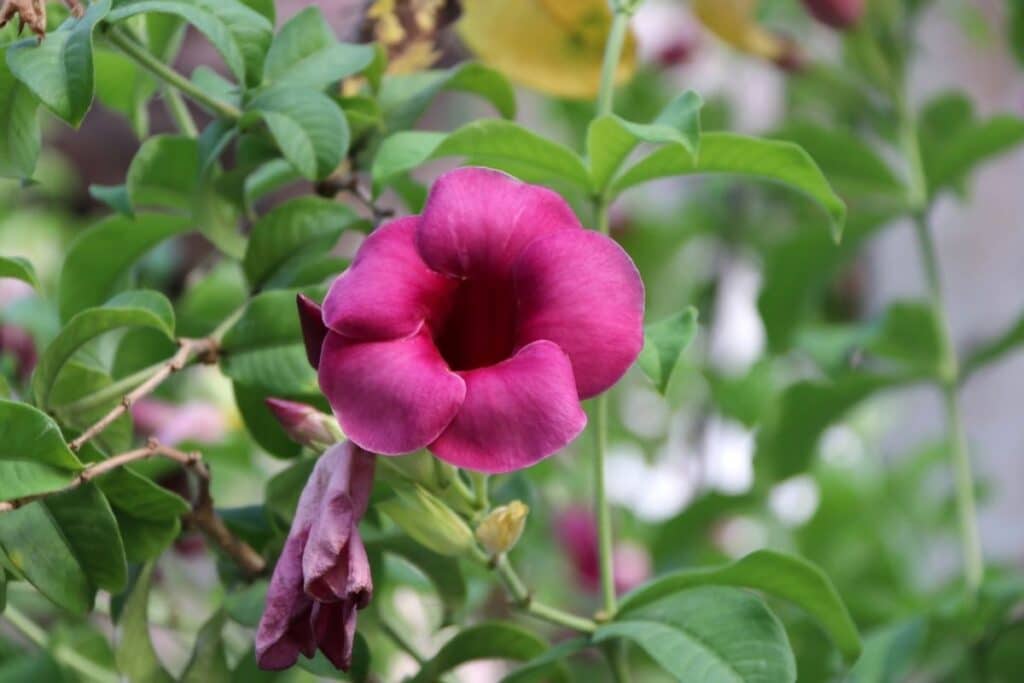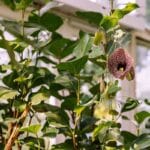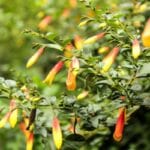Growing Mandevilla Vines is a great way to add a tropical feel to your landscaping. The Mandevilla vine blooms beautiful tropical-looking flowers that—on a healthy plant—are abundant, and grow vigorously throughout the season.
They are a vertically climbing plant, meaning you will want to plant them near a structure of some kind to support the vertical vining growth.
Mandevilla vines can be found in several color varieties. The base colors are red, pink, and white, however, there is a wide range of shades available for each base color.
Although Mandevilla vines are a tropical plant and won’t grow as a perennial in cooler climates, they can be grown as an annual almost anywhere.
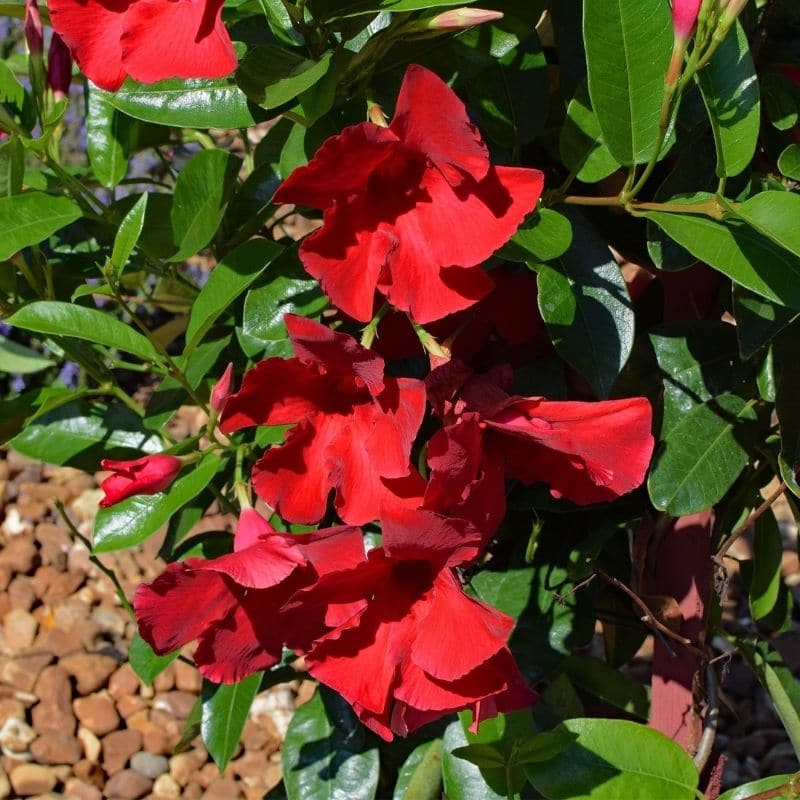
What Are Mandevilla Vines?
Mandevilla vines (Mandevilla spp.) are also known as rock-trumpets due to the shape of their flowers, which have a trumpet-like shape when viewed from the side. They are often confused with the dipladenia bush.
These flowers will bloom early in the season, generally in the middle to late spring. The blooms will stay around until fall when the plant starts to go dormant, giving you a nice long window to keep these beautiful flowers around.
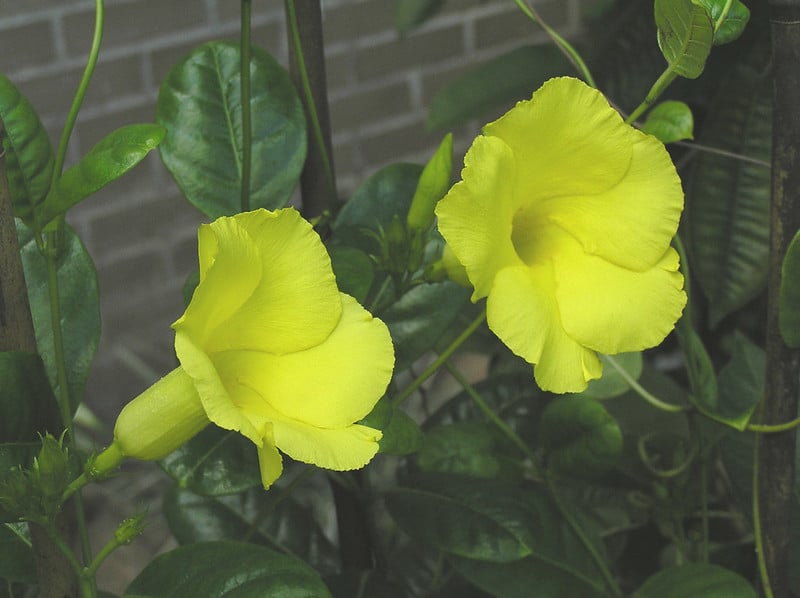
As one of those common climbing plants, the Mandevilla will climb vertically up to 20 feet tall in ideal climates. The vines need a support structure, such as a trellis, to twist around while they grow. These vines are fast-growing, growing up to 10 feet in the first season.
The Mandevilla plant is a tropical vine, meaning they can’t survive cold winters. In USDA hardiness zones 9, 10, and 11, the Mandevilla vine is considered hardy and can be kept as a perennial.
In cooler zones, they can be kept as an annual, or brought inside during the winter to be kept as houseplants until temperatures start to warm back up.
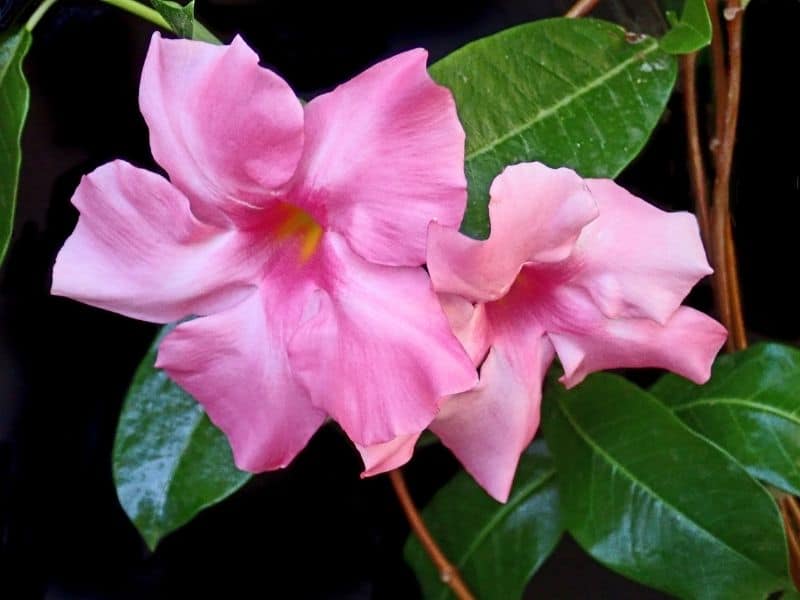
Where to Grow Mandevilla Plants
Mandevilla plants are fast growers and can reach heights of up to 10 feet in a single season. Their quick-climbing nature opens the door to a number of different planting scenarios.
Even if you live in a climate where your Mandevilla vine can only grow as an annual, this speedy climber can create a beautiful attraction in one season.
Archways
Planting your Mandevilla vines at the base of an archway will create a gorgeous walk-through feature for your landscaping.
The Mandevilla plant climbs by wrapping its growth around supports. Most outdoor archways will have a lattice feature for the vines to climb to. If not, the vines may still be able to climb around the edges, depending on their thickness.
Depending on the size of your archway, you may want to plant a Mandevilla vine on each end so they can meet at the top. If you live in USDA hardiness zone 9, 10, or 11, your mature Mandevilla vines may create a beautiful hanging feature once the vines have finished climbing to the top.
In cooler climates, your Mandevilla vines should still reach the top and create a beautiful archway, but you’ll have to replant them each year.
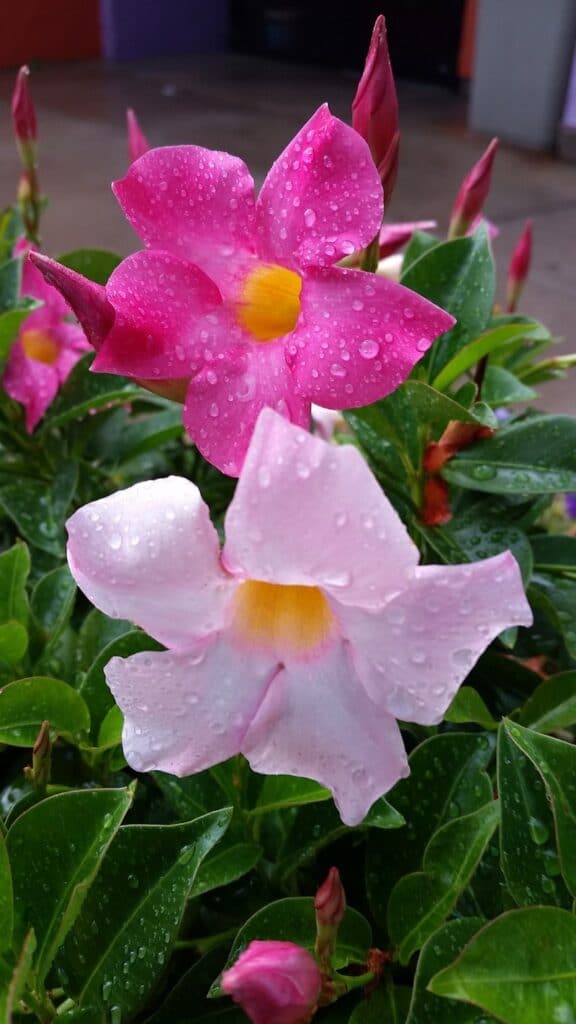
Pergolas
Pergolas are another great option for your Mandevilla vines. Most pergolas are wooden or metal and should have plenty of support options for the vines to grab onto as they climb.
If the legs of your pergola are thick and flat-sided, you may need to run a trellis or rope around the sides so your vines will have something smaller to grab onto.
To create the full tropical effect, you may want to plant a Mandevilla vine on each corner of your pergola so they “overtake” it in a way. A pergola full of Mandevilla vine flowers will make you feel like you’re living on the ocean, even if you’re in the Midwest—we can dream, right?
Trellis
A more traditional option for your Mandevilla vine is to grow them on a trellis. Trellises are built specifically for vining plants, so their rungs are the correct size for a vine to grab onto. Trellises come in a variety of sizes.
For the Mandevilla vine, choosing one that is at least eight feet tall will function best due to the heights the vines can reach.
You can either use a trellis straight in the ground next to your Mandevilla vine, or in a planter with your vine. For those who take their Mandevilla vines inside or in a greenhouse for the winter, a trellis in a planter is the way to go for easy transportation.
Planters
Growing Mandevilla vines in planters is a popular choice for those who live in climates where the vine cannot live through the winter months.
Many choose to keep their Mandevilla vines outside in the summer, and once temperatures reach below 50 degrees Fahrenheit, they bring them inside and keep them as a houseplant.
Although the Mandevilla vine can reach heights of 20 feet or more, when planted in a planter, they are more likely to grow between five to 10 feet. If you want to keep them shorter, supplying a shorter trellis will limit their vertical climbing. Including a trellis within your planter is crucial for your Mandevilla vines to grow vertically.
Fence
Growing your Mandevilla vines along a fence will create a beautiful display for the flowers. Chain link or slatted fence posts make ideal climbing supports because of their rungs which are easy for the vines to grab onto.
If you want to plant your Mandevilla vines along a privacy fence, you may want to consider using trellises against your fence as there may not be enough support for the vines to climb.
Although the Mandevilla vine will not grow thick enough to create a privacy barrier, it can quickly class up a simple fence section. Planting different colors along your fence will add a neat feature to an already beautiful plant.
Flowerbeds
Flower beds are another popular choice for the Mandevilla vine. Some plant their Mandevilla vines in their flower beds with a trellis as support, while others will grow the vines along the outside of the bed.
What better way to decorate a flower bed than with the use of vining flowers?
Another reason people choose to plant their Mandevilla vines in or near their flowerbeds is that they attract hummingbirds. Many put their flower eds near their porch or patio so they can admire their flowers as they relax outdoors—who wouldn’t want to see hummingbirds sipping from their flowers as they sit outside?
Mandevilla Plant Care And Grow Guide
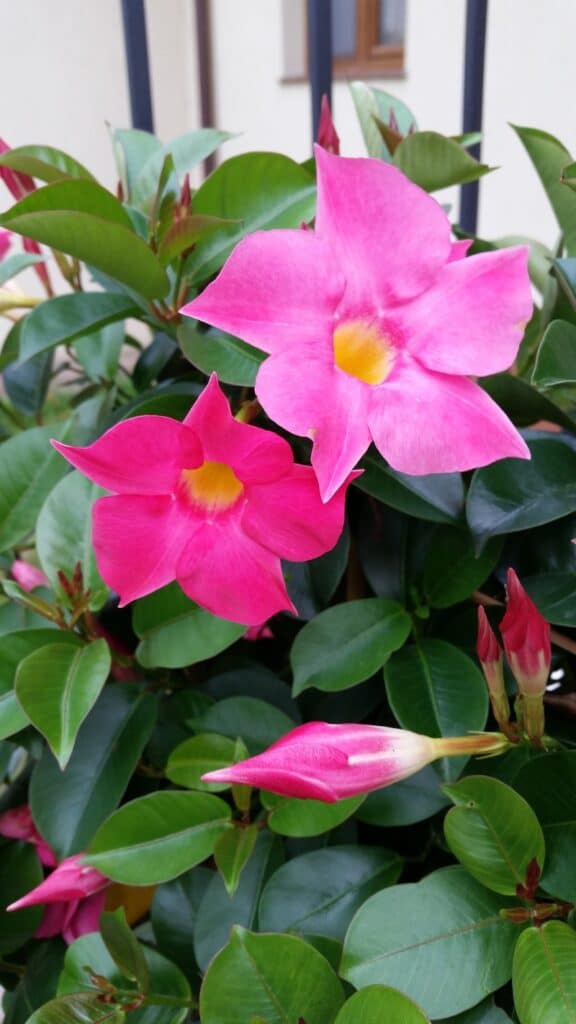
Mandevilla vines are said to be a low-maintenance plant that won’t require much attention outside of their basic plant-care needs. Starting with a good location and good soil will have you well on your way to having a healthy Mandevilla.
With a proper setup and good conditions, you’ll be enjoying your Mandevilla flowers all season long.
Sunlight
A good amount of sunlight is important for the Mandevilla vine as its flowers depend on it. Without enough sunlight, you may not get as many blooms as you would have with proper sunlight—the flowers are the best part!
The Mandevilla vine can be planted as either full sun or a partial shade plant and should do just fine in either condition. Although the full sun is generally the best choice for these plants, if you live in a climate with extreme heat, some shade may help to keep your Mandevilla vine from withering.
As with a lot of different flowering plants, the morning sun is ideal. Full exposure to the morning sun will give your Mandevilla vines a great start to the day because the sun is not as strong early in the morning and is less likely to damage the plant.
The afternoon sun can be much stronger, and has a higher potential to do damage; however, the Mandevilla vine should be able to withstand the afternoon sun if it’s not brutally hot outside.
Water
The Mandevilla vine should be watered regularly to ensure it does not dry out. Keep the soil moist throughout most of the day because it does not do well if the soil is saturated with water.
Allowing the soil to dry out in between watering sessions is also a good practice when caring for a Mandevilla vine.
A slow trickle water hose or a soaker hose on a low setting can work well for the Mandevilla vine for those who do not want to go out and water their plants by hand.
Ensuring that the plant does not sit in pools of water or in saturated soil is important, as this can cause the plant to wilt and die. Pay attention to rainfall and adjust your watering accordingly for the best results.
Soil
To keep your Mandevilla vine from sitting in soil that is saturated with water, consider planting in soil that has good drainage. Well draining soil will keep water from pooling around the roots to prevent root rot.
If your ground soil is too heavy and does not drain well, you may want to plant your Mandevilla vine in a planter or flower bed with potting soil. You can also mix in better soil along with your ground soil over time.
The Mandevilla vine also does best in soil that has a high nutrient content, particularly nitrogen and calcium. Starting your Mandevilla vine with the right soil is an important step when planting, as this will set your plant up for success right off the bat.
If you intend to overwinter the plant indoors, place it in a container with drainage holes and fill it with all-purpose potting soil.
Fertilizer
Fertilizer is not always necessary with the Mandevilla vine, but it can help to increase the number of flowers that bloom each season. If you are transplanting a young Mandevilla vine into the soil, you should not add fertilizer right away.
Adding fertilizer to a plant that is new to the soil can shock the plant—the nutrients from the soil along with the nutrients from the fertilizer can be overwhelming.
Once the Mandevilla vine is around six to twelve months old, you can start to add fertilizers as needed. To enhance blooming, feed Mandevilla plants every two weeks with a slow-release formula or phosphorus-rich liquid fertilizer.
As mentioned before, nitrogen and calcium are important for the Mandevilla vine, so choosing a fertilizer that has these nutrients is important if the soil cannot provide enough on its own.
Pruning
Pruning your Mandevilla vine is an important part of keeping it healthy, even if it is not overgrown.
Trimming off old growth can help conserve energy for new growth, and can result in more blooming flowers. You can, of course, also trim off any growth that is becoming unruly or is growing in a direction that is undesirable.
It is best to prune your Mandevilla vine before new growth occurs, in late winter or early spring. If you do some pruning during the growing season, make sure to take it easy and do not take off too much at once. Over-pruning can result in an unhealthy plant that does not flower heavily.
Propagate
Mandevilla vines can be propagated through stem cuttings with relative ease. To propagate Mandevilla, take a 4 to 6-inch cutting from a healthy, mature stem, ensuring it has at least two pairs of leaves.
Remove the lower leaves, dip the cut end in rooting hormone, and plant it in a well-draining potting mix. Keep the soil consistently moist, and provide a warm and bright environment until the cutting establishes roots, typically within a few weeks to a couple of months.
Pests That Can Harm Mandevilla Vines
There are some common pests that can harm your Mandevilla vines that are worth keeping an eye out for. Preventing these pests is simple, and is easiest done prior to any infestations. If you do end up with some pest problems, there are easy methods of getting rid of them.
Aphids
Aphids are a common pest for many plants, including the Mandevilla vine. Aphids will attach themselves to the undersides of leaves and feast on the plant’s nutrients.
A healthy plant can withstand a small aphid infestation, but when a plant is unhealthy and weak, it is much more susceptible to the effects of aphids. A plant that is affected by aphids may start declining with yellowing leaves that start to fall off.
Thankfully, aphids are fairly simple to get rid of, especially if noticed early on. If the infestation is not too large, you can sometimes get away with spraying the aphids off your plant with water from your hose.
Alternatively, you can use a light pesticide that is safe for plants. Applying neem oil via a light spray can help to prevent aphids from ever becoming a problem at all.
Mealybugs
Mealybugs have a similar effect on plants that aphids do—they suck nutrients from the leaves. A mealybug infestation is most likely to occur on plants that are not getting enough water.
Plants that are not getting enough water may also be unhealthy, making the impact of the mealybugs even worse for the plant.
A plant that is infested with mealybugs will have leaves that start to turn yellow and fall off. Small sections of branches may also begin to droop and wilt and eventually the plant will die if no intervention is done.
Mealybugs can be removed from your plants with the use of rubbing alcohol. If the infestation isn’t too large, you may be able to use a cotton swab dabbed in alcohol to wipe off any visible mealybugs.
You can also create a concoction of rubbing alcohol, dish soap, and water to spray on the plant—this should take care of any mealybugs that may be snacking on your Mandevilla vine.
Spraying a light coat of neem oil can also help to prevent mealybugs from ever visiting in the first place, so it’s a great thing to have around.
Spider Mites
Spider mites are one of the more pesky pests to get rid of. When they infest a plant, they feed off the plant’s tissues, causing spotting on the leaves which will eventually lead to yellowing and dead leaves.
Spider mites leave a light webbing on the plants, which is a common sign of infestation.
There aren’t many at-home remedies for removing spider mites because they are particularly resilient. If your Mandevilla vine does become infested with spider mites, an organic pesticide is your best chance at getting rid of them.
Neem oil has also been known to assist in the removal of spider mites and will deter them from infesting if sprayed early on.
How To Keep Your Mandevilla Vine Healthy
Checking your Mandevilla vine for pests every few weeks is an important part of keeping your plants healthy. Even if using a pest preventative such as neem oil, it is a good idea to check often. Most pests are much easier to get rid of if noticed early on.
If you are planning on bringing your Mandevilla plant inside during the winter months, you may want to give your plant a heavy check-over for any pests, because you will not want them in your home.
Otherwise, these plants are hardy, easy to grow, and sure to please.
To see more gorgeous flowers, check our list of flowers from A-Z as well as Trumpet Vine – a similar looking flower.
*Featured image by depositphotos.com/Au_hoo

